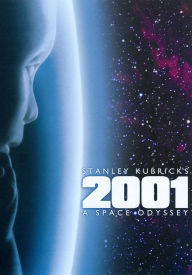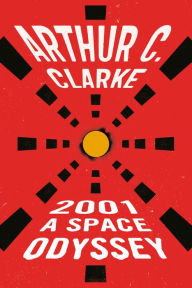Space Odyssey: Stanley Kubrick, Arthur C. Clarke, and the Making of a Masterpiece

By any yardstick, Stanley Kubrick’s 2001: A Space Odyssey, is one of the towering achievements of modern cinema, a work that in equal parts beguiles us, thrills us, frightens us, gives us hope in human resiliency. Since its release fifty years ago—the film has felt like an entity unto itself, alive with all of the possibilities of the cinema, which makes it perfect for the biographical treatment that Michael Benson lavishes upon it in Space Odyssey: Stanley Kubrick, Arthur C. Clarke, and the Making of a Masterpiece.
Space Odyssey: Stanley Kubrick, Arthur C. Clarke, and the Making of a Masterpiece
Space Odyssey: Stanley Kubrick, Arthur C. Clarke, and the Making of a Masterpiece
Hardcover $30.00
Benson, whose love for the film feels like a kind of duty to get his expose of its creation right, possesses a stick-to-itiveness on the research front that offers up the bulk of this book’s meat. He also has highly-attuned critical faculties, viewing what he sees as someone like James Agee once did, though without the level of Agee’s prose. As 2001 was a bit like Ulysses in space, it seems appropriate that Benson is challenging himself with an epic task: to not only chart the earliest moments of conception of this complicated masterpiece, but the courtship that led to perhaps sci-fi’s greatest consummation, that taking place between Kubrick the director, and pioneering science fiction author Arthur C. Clarke.
Benson, whose love for the film feels like a kind of duty to get his expose of its creation right, possesses a stick-to-itiveness on the research front that offers up the bulk of this book’s meat. He also has highly-attuned critical faculties, viewing what he sees as someone like James Agee once did, though without the level of Agee’s prose. As 2001 was a bit like Ulysses in space, it seems appropriate that Benson is challenging himself with an epic task: to not only chart the earliest moments of conception of this complicated masterpiece, but the courtship that led to perhaps sci-fi’s greatest consummation, that taking place between Kubrick the director, and pioneering science fiction author Arthur C. Clarke.
2001: A Space Odyssey
2001: A Space Odyssey
Cast
Keir Dullea
,
Gary Lockwood
,
William Sylvester
,
Daniel Richter
,
Leonard Rossiter
Director
Stanley Kubrick
In Stock Online
DVD
$9.99
$14.99
Believing that there never had been a great sci-fi film, and fresh from the success of Dr. Strangelove, or: How I Stopped Worrying and Learned to Love the Bomb, Kubrick turned his attention to the heavens. As a reader of everything, he knew the work of Clarke, who lived in Ceylon with his boyfriend filmmaker, and who was a sort of astrology-savant. The man knew as much about the stars and space as a scientist, we learn from Benson’s various anecdotes. Benson is skilled at bringing us in on this courtship, with Clarke flying to NYC, a man far from home, but finding a surrogate home with Kubrick’s brood, even as Kubrick is using Clarke solely for his expertise and writerly gifts. Not this was lost on the sagacious Clarke, whose good humor is seen as crucial to the partnership.
What is particularly fascinating about Benson’s accounts are how mundanity often leads to profundity. The story of how the famous black monolith—so simple, so crucial, so defining—came to be reads like a hilarious mish-mash of a HGTV segment gone way awry, crossed with a stay-at-home parent’s obsession with keeping the kids’ smudges off the sliding glass door. Monoliths kept being made, monoliths kept being thrown out. “Even the one that ultimately passed muster—the monolith—wasn’t immune to directorial criticism,” Benson writes. “Although its form and finish were impeccable, dusty fingerprints could sometimes be seen on its surface with extraordinary clarity.”
But it’s the subtler critical comments that raise up Benson’s efforts. In 2001, we have, as Benson points out, what is nearly a silent film and yet a picture where the sound design—the acoustic architecture of space and the abysses within all of us—matters more than perhaps in any other Hollywood film outside of Citizen Kane. Benson quotes Kubrick’s remark about moveigoers “paying attention with their eyes.” The film is a slow visual burn, and Benson teases out how much effort went into making a given image, forever to be emblazoned upon the mind’s eye, come off so effortlessly on the big screen. Benson also builds the argument that what undeniably appeared preternaturally epic on the big screen was a result of pruning during the creative process, a director building his vision by understanding what it meant to stay true to one.
We also see how Kubrick was able to endue his film with its singular pace by chopping out many of what he and Clarke at times considered their best ideas. Thinking Clarke was out of his element in writing a script rather than a novel, Kubrick has his screenwriter pen a novel instead, from which the two will shape their script. amount of bristling in check.
Believing that there never had been a great sci-fi film, and fresh from the success of Dr. Strangelove, or: How I Stopped Worrying and Learned to Love the Bomb, Kubrick turned his attention to the heavens. As a reader of everything, he knew the work of Clarke, who lived in Ceylon with his boyfriend filmmaker, and who was a sort of astrology-savant. The man knew as much about the stars and space as a scientist, we learn from Benson’s various anecdotes. Benson is skilled at bringing us in on this courtship, with Clarke flying to NYC, a man far from home, but finding a surrogate home with Kubrick’s brood, even as Kubrick is using Clarke solely for his expertise and writerly gifts. Not this was lost on the sagacious Clarke, whose good humor is seen as crucial to the partnership.
What is particularly fascinating about Benson’s accounts are how mundanity often leads to profundity. The story of how the famous black monolith—so simple, so crucial, so defining—came to be reads like a hilarious mish-mash of a HGTV segment gone way awry, crossed with a stay-at-home parent’s obsession with keeping the kids’ smudges off the sliding glass door. Monoliths kept being made, monoliths kept being thrown out. “Even the one that ultimately passed muster—the monolith—wasn’t immune to directorial criticism,” Benson writes. “Although its form and finish were impeccable, dusty fingerprints could sometimes be seen on its surface with extraordinary clarity.”
But it’s the subtler critical comments that raise up Benson’s efforts. In 2001, we have, as Benson points out, what is nearly a silent film and yet a picture where the sound design—the acoustic architecture of space and the abysses within all of us—matters more than perhaps in any other Hollywood film outside of Citizen Kane. Benson quotes Kubrick’s remark about moveigoers “paying attention with their eyes.” The film is a slow visual burn, and Benson teases out how much effort went into making a given image, forever to be emblazoned upon the mind’s eye, come off so effortlessly on the big screen. Benson also builds the argument that what undeniably appeared preternaturally epic on the big screen was a result of pruning during the creative process, a director building his vision by understanding what it meant to stay true to one.
We also see how Kubrick was able to endue his film with its singular pace by chopping out many of what he and Clarke at times considered their best ideas. Thinking Clarke was out of his element in writing a script rather than a novel, Kubrick has his screenwriter pen a novel instead, from which the two will shape their script. amount of bristling in check.
2001: A Space Odyssey (Space Odyssey Series #1)
2001: A Space Odyssey (Space Odyssey Series #1)
In Stock Online
Paperback $9.99
In Benson’s account, Clarke is the hero of the film’s genesis, perhaps as crucial in his way as Kubrick, as larger-than-life filmmaker, was. Clarke certainly gifted the film its entheogenic aspect, which obviously suited its times, but paid larger rewards later, outside of the psychedelia claptrap of the 1960s, and now more than ever, as our emotional scaffolding seems to break down more by the day, and we dose ourselves with the lies that make our existence more tenable.
It is telling how much like HAL—the computer in search of a soul, who alters narratives and facts for his own purposes—we are becoming, and it’s that kind of wrongly-approached, techno-babble, amina-quest that devolves our shared humanity, both in 2001 and in our current culture. As such, reading this book feels timely, not a slog through a movie where minutiae are inevitably a large part of its story—Kubrick truly was one of the great detail-mad/obsessed directors—but without becoming an anchor.
Benson’s deeply-researched style has its flaws – he leans on the word “however” so much that one starts counting the occurrences per paragraph. But a pleasing effect of Benson’s deep dives into the background material is how it encourages readers to revisit Clarke’s work. He comes off as less of Kubrick’s intellectual equal—though we are more on Kubrick’s turf, so to speak—but the more interesting artist because he’s more flexible in his thinking. Where Kubrick prefers the draconian, Clarke has no problem making a (temporary) ass of himself, as with his hilarious suggestion, nonetheless made in earnest, that the film should end with some space creature cooingly wanting to be petted, its motion compared to a priapic member all rarin’ to go, let’s do this! style.
Suffice it to say, they went with something else, the film’s eventual eureka moments being those that the duo worked at the longest. If Kubrick is justly celebrated for the arrival of a classic on earth, Benson helps us see how Clarke, along with many others, made this strange vision something we can’t imagine cinema without.
In Benson’s account, Clarke is the hero of the film’s genesis, perhaps as crucial in his way as Kubrick, as larger-than-life filmmaker, was. Clarke certainly gifted the film its entheogenic aspect, which obviously suited its times, but paid larger rewards later, outside of the psychedelia claptrap of the 1960s, and now more than ever, as our emotional scaffolding seems to break down more by the day, and we dose ourselves with the lies that make our existence more tenable.
It is telling how much like HAL—the computer in search of a soul, who alters narratives and facts for his own purposes—we are becoming, and it’s that kind of wrongly-approached, techno-babble, amina-quest that devolves our shared humanity, both in 2001 and in our current culture. As such, reading this book feels timely, not a slog through a movie where minutiae are inevitably a large part of its story—Kubrick truly was one of the great detail-mad/obsessed directors—but without becoming an anchor.
Benson’s deeply-researched style has its flaws – he leans on the word “however” so much that one starts counting the occurrences per paragraph. But a pleasing effect of Benson’s deep dives into the background material is how it encourages readers to revisit Clarke’s work. He comes off as less of Kubrick’s intellectual equal—though we are more on Kubrick’s turf, so to speak—but the more interesting artist because he’s more flexible in his thinking. Where Kubrick prefers the draconian, Clarke has no problem making a (temporary) ass of himself, as with his hilarious suggestion, nonetheless made in earnest, that the film should end with some space creature cooingly wanting to be petted, its motion compared to a priapic member all rarin’ to go, let’s do this! style.
Suffice it to say, they went with something else, the film’s eventual eureka moments being those that the duo worked at the longest. If Kubrick is justly celebrated for the arrival of a classic on earth, Benson helps us see how Clarke, along with many others, made this strange vision something we can’t imagine cinema without.


